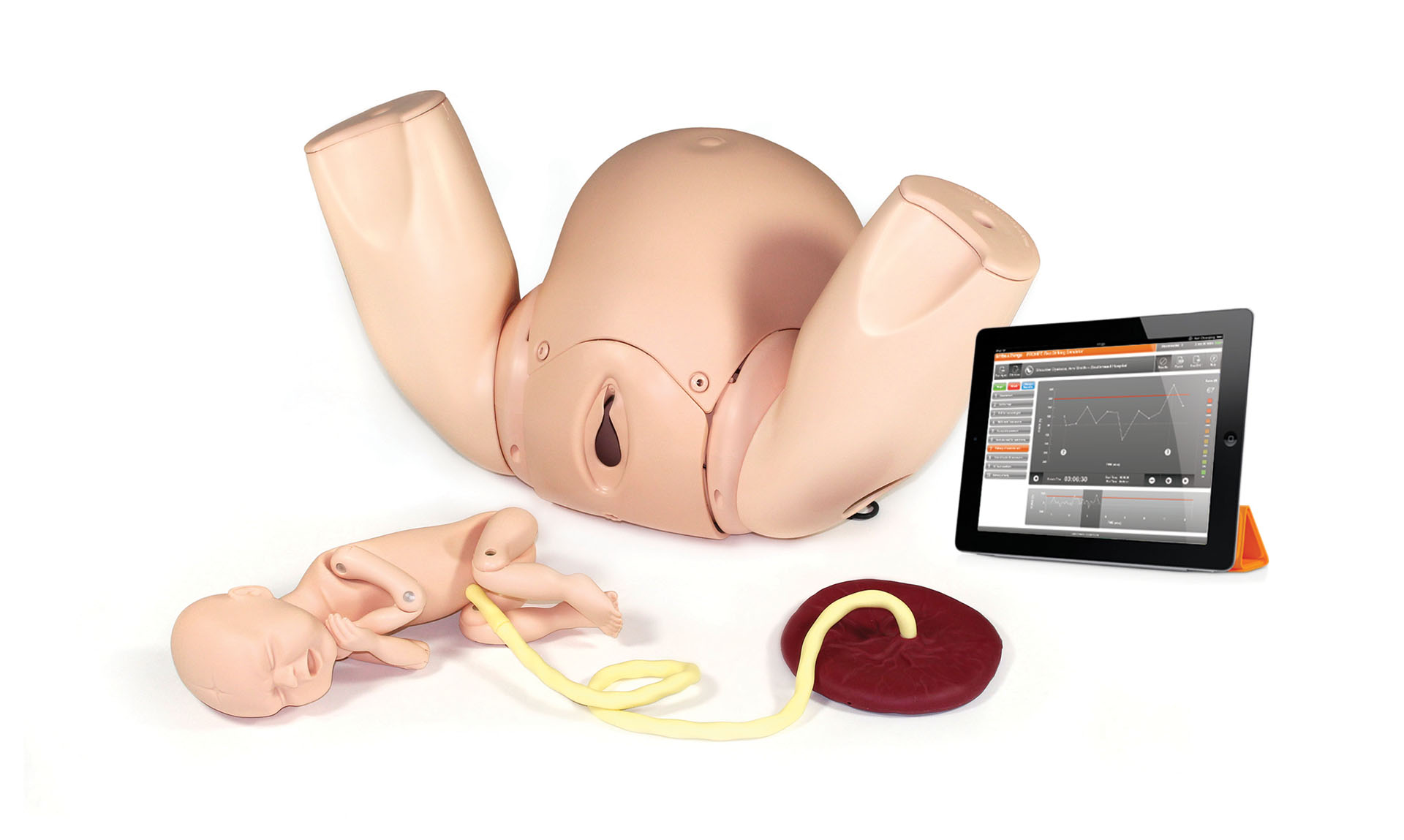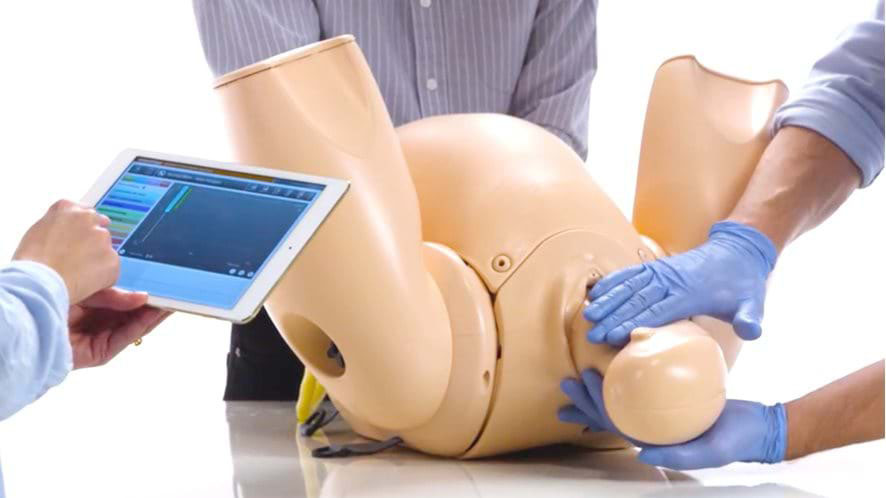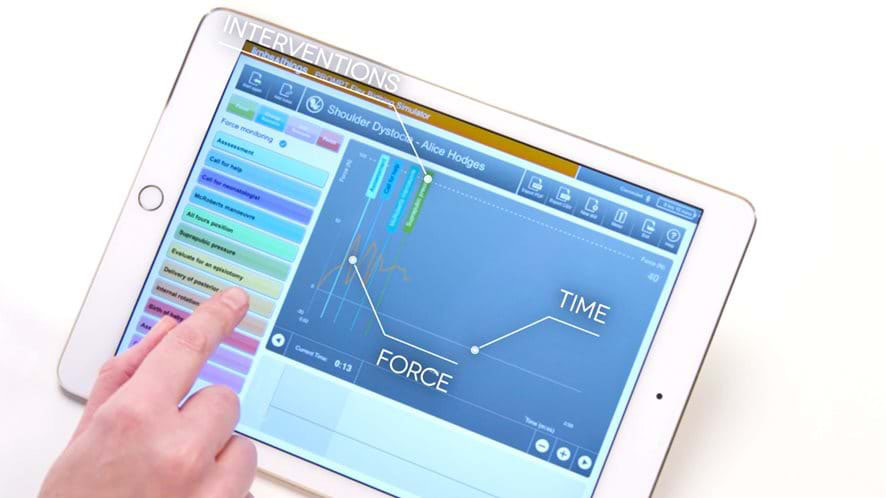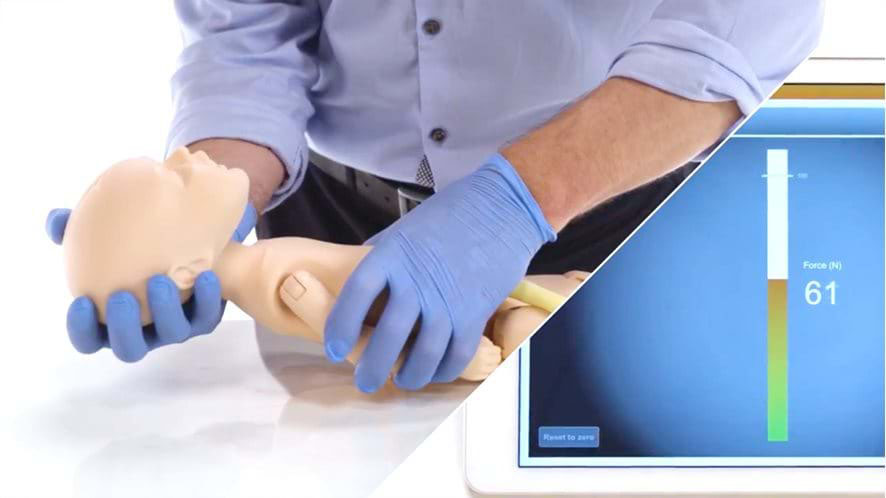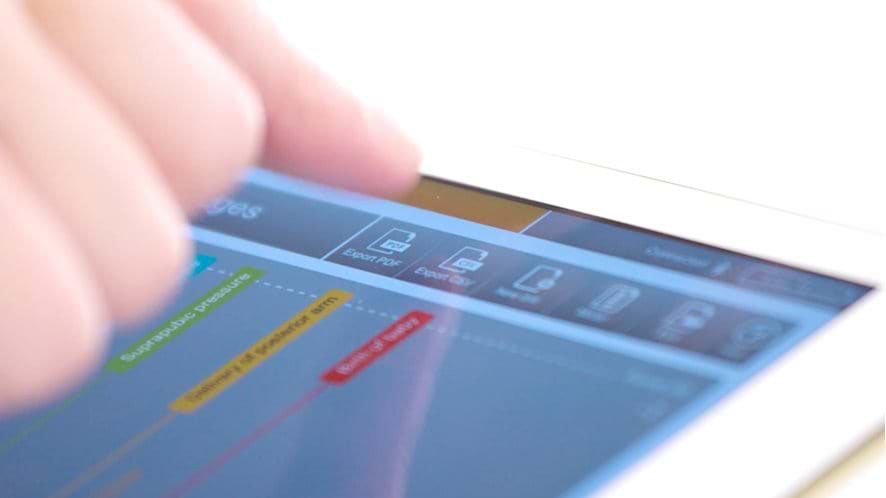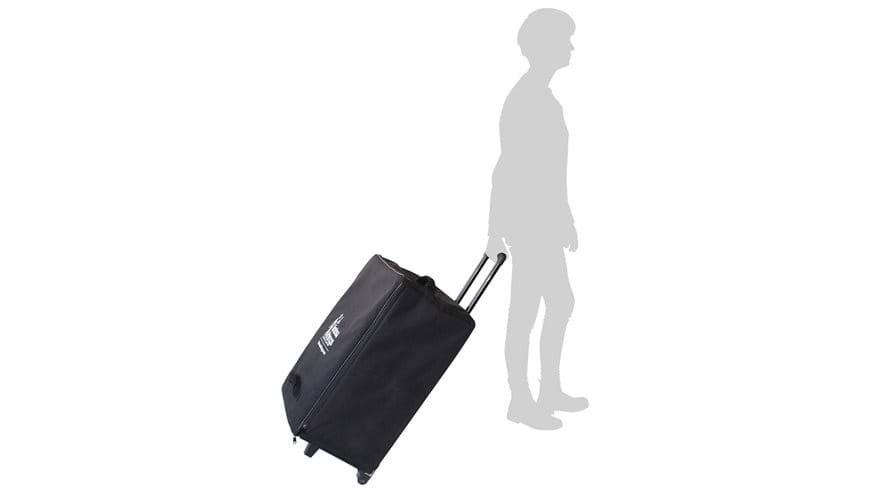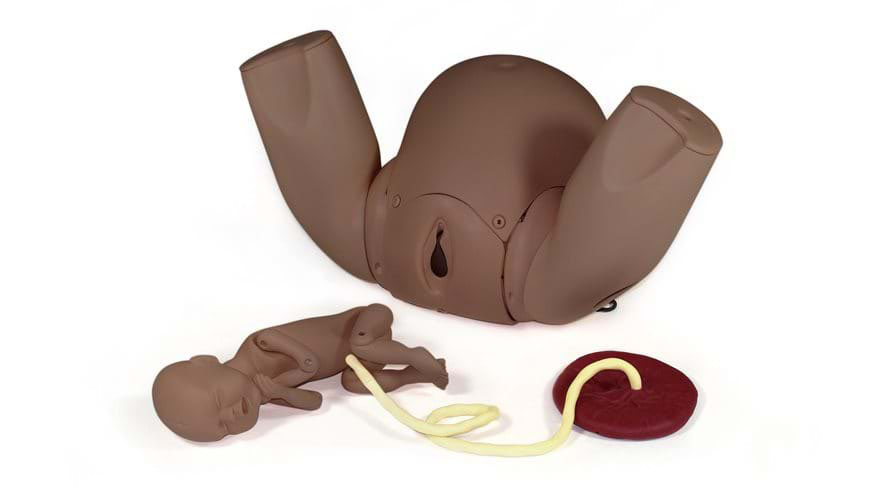Prompt Flex Birthing Simulator - Advanced, Light
The Advanced Limbs & Things' PROMPT Flex Birthing Simulator is the ideal hybrid training solution. Quick and easy to set up out of the box for classroom training, or secured to a bed for more realistic bedside scenarios.
See more detailsDiagnostic / Procedural Skills, Midwifery / Obstetrics / Gynaecology, Nursing, OSCEs, Postgraduate Clinical Skills, Trauma / Emergency / Acute Care, Undergraduate Clinical Skills.
Skills
- Training and practice in the following types of birth:
- Normal
- Vaginal breech birth
- Shoulder dystocia with force feedback – force feedback is unique to this model and not available on the PROMPT Flex Standard
- Vaginal assisted (forceps and vacuum devices)
- Third stage of labour
- Cord prolapse
- Urinary catheter placement
- IM injection Communication and teamwork skills
Features
- Anatomically correct, the birthing mother and baby are designed to allow for multiple true-to-life training scenarios
- In addition to the Standard PROMPT Flex’s functionality, the baby included with this model is equipped with Force Monitoring software
- During labour and delivery, force exerted on the baby can result in brachial plexus injury during shoulder dystocia
- The Force Monitoring Baby measures the force applied by trainees during drills
- Using the birthing simulator’s software, instructors can record actions taken, interventions made, and the length of time to deliver the baby, providing insights into students’ skills
- Meter Mode in the Force Monitoring software allows trainees valuable practice, giving familiarity with the feel of safe and excessive force before encountering a real obstetric emergency
- Software is compatible with Windows, Mac, iOS and Andriod, and can be run on tablets as well as PCs
- User definable text in the software allows for intervention and birthing scenario names to be edited into the user’s native language
- The PROMPT Flex range offers multiple scenarios that can include patient simulation training
- PROMPT Flex’s modular design allows for multiple training scenarios that you can tailor to your specific course needs
- Additional modules include:
- Postpartum Hemorrhage (PPH)
- Enhanced C-Section
- Cervical Dilatation & Effacement (CD&E)
- Cervical Cerclage
- Lower Legs
- Compression Suture Uterus
- Baby model has improved shoulder and hip joints
- Bluetooth enabled baby allows for Force Monitoring with a scenario-based software (downloadable from the website)
- Drills run with the software can be recorded for later review
- Comes with wheeled carry case for safe storage and transportation
- The PROMPT Flex Range can offer a complete training solution for birth management
- Gynaecoid shape pelvis with soft, flexible birth canal, dilatable cervix and pelvic floor musculature provides realism in normal and complicated births
- Baby model represents a full term infant in weight and size, allowing for realistic handling
- Force Monitoring software allows trainees to accurately learn the safe amount of force that can be administered during delivery
Birthing Mother:- Stand alone or hybrid use, 3 straps are supplied to secure PROMPT simulator for bench top or bed mounting
- Articulated thighs help to demonstrate Gaskin and McRobert’s procedures
- Handle on the base of the mannikin for operator use during labor simulation
- Can be used with additional modules to extend training simulations
- Anatomy of the PROMPT Birthing Mother:
- Birth canal and cervix
- Ischial spines and pubic bone
- Gynaecoid pelvis
- Articulating Thighs, with injection pad
- Abdomen
- Baby:
- Improved articulation of the joints offers enhanced realism for difficult birthing scenarios, such as shoulder dystocia
- Anatomy of the PROMPT Baby:
- Umbilical cord and placenta (detachable)
- Clavicles
- Suture lines and fontanelles
Evidence
“Training for Shoulder Dystocia: A Trial of Simulation Using Low-Fidelity and High-Fidelity Mannequins.”
Crofts, J. F., C. Bartlett, et al. (2006). “Training for Shoulder Dystocia: A Trial of Simulation Using Low-Fidelity and High-Fidelity Mannequins.” Obstet Gynecol 108(6): 1477-1485.
“Management of Shoulder Dystocia: Skill Retention 6 and 12 Months After Training.”
Crofts, J. F., C. Bartlett, et al. (2007). “Management of Shoulder Dystocia: Skill Retention 6 and 12 Months After Training.” Obstet Gynecol 110(5): 1069-1074.
“Shoulder dystocia training using a new birth training mannequin.”
Crofts, J. F. A., Georgios; Read, Mike; Sibanda, Thabani; Draycott, Timothy J. (2005). “Shoulder dystocia training using a new birth training mannequin.” BJOG: An International Journal of Obstetrics & Gynaecology 112(7): 997-999.
“Patient-actor perception of care: a comparison of obstetric emergency training using manikins and patient-actors.”
Crofts, J. F. B., C; Ellis, D; Winter, C; Donald, F; Hunt, L P; Draycott, T J (2008). “Patient-actor perception of care: a comparison of obstetric emergency training using manikins and patient-actors.” Quality & Safety in Health Care 17(1): 20-24.
“Improving Neonatal Outcome Through Practical Shoulder Dystocia Training.”
Draycott, T. J., J. F. Crofts, et al. (2008). “Improving Neonatal Outcome Through Practical Shoulder Dystocia Training.” Obstet Gynecol 112(1): 14-20.
Objective: To compare the management of neonatal injury associated with shoulder dystocia before and after introduction of mandatory should dystocia simulation training.
Conclusion: The introduction of shoulder dystocia training for all maternity staff was associated with improved management and neonatal outcomes of births complicated by shoulder dystocia.
“Shoulder Dystocia: Using Simulation to Train Providers and Teams.”
Fahey, J. O. M., MPH, CNM; Mighty, Hugh E. MD (2008). “Shoulder Dystocia: Using Simulation to Train Providers and Teams.” Journal of Perinatal & Neonatal Nursing 22(2): 114-122.
Includes
- Birthing Mother (with Upper Legs)
- Wireless Force Monitoring Baby (Bluetooth)
- Placenta
- Abdomen for Prompt Flex
- Perineum & birth Canal for Prompt Flex
- Prompt Flex – PPH Module
- Carrying case
- Instructions for downloading software
Cleaning
- Clean off excess lubricant from all mother and baby surfaces
- Wipe clean the product with a damp soft cloth, warm water and mild detergent
- NOTE: Force Monitoring Baby module contains electronics and should not be immersed in water when cleaning
- Allow the birthing trainer and its components to dry before storing
Safety
- This product is latex free
- A poorly lubricated baby or placenta may damage the birth canal or cervix when pushed through during a procedure
- We recommend lubricating the cervix, birth canal and baby before each birth
- We recommend using Limbs & Things lubricant, non-recommended fluid products may weaken or damage the trainer
- Wear gloves at all times, and remove all sharp objects. Sharp surfaces (such as fingernails and rings) can lead to silicone damage
- Force Monitoring Baby contains electronic components, do not immerse in water
- EC Declaration of Conformity, in accordance with ISO IEC 17050-1:2010
- UKCA Declaration of Conformity, in accordance with UK Government Guidance
- FCC Declaration of Conformity, in accordance with standard 47CFR:2008 Part 15, Sub Part C, clauses 15.207 & 15.209
Manufacturer
Limbs & Things
Related Spares and Repairs
| SKU | Product Name | Price | Action |
|---|---|---|---|
| ALT80124 | Abdomen for Prompt Flex, Light | Price on request | View Product |
| ALT60133 | ART Mat for PROMPT Flex Birthing Simulator | Price on request | View Product |
| ALT10199 | Birthing Lubricant | Price on request | View Product |
| ALT80120 | Birthing Mother With Upper Legs, Light | Price on request | View Product |
| ALT00020 | Concentrated Venous Blood – Starter Pack (2) | Price on request | View Product |
| ALT00021 | Concentrated Venous Blood Refill | Price on request | View Product |
| ALT80110 | Lower Legs With Knee Joint Interface, Light | Price on request | View Product |
| ALT80125 | Perineum & Birth Canal for Prompt Flex, Light | Price on request | View Product |
| ALT80123 | Placenta (1) | Price on request | View Product |
| ALT80102 | Prompt Flex Cervial Dilation & Effacement Module, Light | Price on request | View Product |
| ALT80180 | Prompt Flex Cervical Cerclage Module, Light (CCM) | Price on request | View Product |
| ALT80300 | Prompt Flex Enhanced Caesarean Section Module, Light (ECSM) | Price on request | View Product |
| ALT80101 | Prompt Flex Postpartum Haemorrhage Module | Price on request | View Product |
| ALT80122FM | Wireless Force Monitoring Baby, Light (Bluetooth) | Price on request | View Product |
